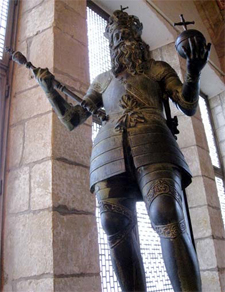 Twelve hundred years ago tomorrow—January 28, 814—the Franks lamented the death of a tall, paunchy, mustachioed king whom they already knew was one of the most important people in European history: Karl or Charles the Great, Karolus Magnus, Charlemagne. His biographers cataloged the omens that presaged his death, and poets insisted that all the world wept for him. But they mourned too late; the old man they interred in the cathedral had long been lost to legend and myth.
Twelve hundred years ago tomorrow—January 28, 814—the Franks lamented the death of a tall, paunchy, mustachioed king whom they already knew was one of the most important people in European history: Karl or Charles the Great, Karolus Magnus, Charlemagne. His biographers cataloged the omens that presaged his death, and poets insisted that all the world wept for him. But they mourned too late; the old man they interred in the cathedral had long been lost to legend and myth.
The Charlemagne most of us know is a literary creation: a chivalric ancestor, an Arthur-like figure encircled by heroes, an enigma whose name legitimizes fundamentalist prophecies, spurious movie quotes, heavy-metal concept albums, and (mirabile dictu) overpriced shower gel. Across centuries, Karl’s propagandists can rightly claim victory—but as someone suspicious of power, I’m interested in a different judgment of the man, one that shows how some people felt about him when he wasn’t yet cold in his tomb.
In 824, on the island of Reichenau, a book-obsessed monk named Wettin fell ill. He crawled into bed and suffered terrifying visions: First, he saw an evil, robed spirit looming over his bed with torture devices; then he went on a vivid tour of Hell, Purgatory, and Heaven led by his own guardian angel.
From his deathbed, Wettin recounted his revelations to a monk named Haito. Two years later, one of Wettin’s former students, Walafrid Strabo, rewrote the account as a long poem, “The Vision of Wettin.” Walafrid later tutored Charlemagne’s grandson and served as abbot of Reichenau. His flair for poetry and his love of gardening have earned him a tag on this blog and a poem in the gargoyle book, but when you’re assessing Charlemagne, one scene from his “Vision of Wettin” really stands out.
Here it is, hastily translated (by me) from Latin into metrical, alliterative lines:
Casting his eyes over the landscape,
He beheld the late king of the high-born Romans
And all of Italy unable to move,
Rent by a beast that ravaged his genitals;
Left free of ruin was the rest of his body.
“Explain this!” cried Wettin, witless with horror.
“Many things fell to this man in his life:
Attempting to nourish a new age of laws,
Goading the teachings of God to prosper,
Nobly protecting his pious subjects,
Eventually reaching that rare summit
Where upholding virtue invites sweet praise,
But here he is held under horrid conditions,
Enduring great pain and punishment. Why?”“This torment engulfs him,” his guide replied,
“Because he disfigured with filthy pleasures
His noble deeds, and doubted not
That his sins would be subsumed by his goodness,
Ending his life in the usual sordidness.
Even so, he will toil to attain splendor
And delight in the honor his Lord has prepared.”
(MGH Poetae II 318–319, ll. 446–465)
Make what you will of the prospects for Charlemagne’s soul; after his death, people grew comfortable recording in writing what they’d likely been saying for years. Heirs and hangers-on had reasons for praising or damning the actual man—but before long, medieval people were more interested in letting the real Karl rot while recasting “Charlemagne” to suit their own needs. In the year ahead, we’ll rediscover how true that still is.
 Tomorrow’s anniversary kicks off the “Karlsjahr,” a flurry of Karolocentric commemorations, exhibitions, symposia, and other events coinciding with the septennial Catholic pilgrimage to Charlemagne’s cathedral at Aachen. The city will host three major exhibitions of artifacts and art; an artist will install 500 Charlemagne statues in a public square; and a new Aachen Bank card will show off the famous reliquary bust. The town of Ingelheim will host an exhibition, and the abbey church in the Swiss village of Müstair will serve up a display about Carolingian architecture, a “collage-opera” about Charlemagne’s imperial coronation, and a comedy performance, “Karl and the White Elephant”—and these are only the events I’ve discovered so far.
Tomorrow’s anniversary kicks off the “Karlsjahr,” a flurry of Karolocentric commemorations, exhibitions, symposia, and other events coinciding with the septennial Catholic pilgrimage to Charlemagne’s cathedral at Aachen. The city will host three major exhibitions of artifacts and art; an artist will install 500 Charlemagne statues in a public square; and a new Aachen Bank card will show off the famous reliquary bust. The town of Ingelheim will host an exhibition, and the abbey church in the Swiss village of Müstair will serve up a display about Carolingian architecture, a “collage-opera” about Charlemagne’s imperial coronation, and a comedy performance, “Karl and the White Elephant”—and these are only the events I’ve discovered so far.
For 1,200 years, Europeans have crafted a Karl for all seasons. Later medieval kings grafted him to their family trees, Crusaders invoked him, the French made him an icon of education, and Napoleon and Hitler believed they were continuing his work. His latest incarnation is also explicitly political: When the 1957 Treaty of Rome created the European Community, the six signatory nations covered almost the exact same territory as his empire. The EU’s headquarters in Brussels, the dull Charlemagne Building, enshrines him as the patron saint of European unity—and someday, perhaps, of murky bureaucracy. Statues rise, stained glass dazzles, and the source of the legend is lost.
In Becoming Charlemagne, I likened Karl’s tiny capital to the king himself: “almost civilized and unexpectedly alive: ambitious, forceful, clearly Christian, slightly cruel.” He once slaughtered helpless Saxon captives, an atrocity that shocked his contemporaries, and it wasn’t always propitious to be his relative. His failings, both personal and political, were as great as his ambitions.
 But take a second look: There’s a remarkable, complex person beneath centuries of rhetoric and legend. It’s the rare leader indeed who can smile at endless flattery, enjoying obsequious poems praising him as a second David, yet still demonstrate, through his actions, that he knows he isn’t the apotheosis of his civilization—that the future needs books, buildings, and institutions that endure.
But take a second look: There’s a remarkable, complex person beneath centuries of rhetoric and legend. It’s the rare leader indeed who can smile at endless flattery, enjoying obsequious poems praising him as a second David, yet still demonstrate, through his actions, that he knows he isn’t the apotheosis of his civilization—that the future needs books, buildings, and institutions that endure.
At this, Karl failed—but 1,200 years later, individuals, nations, and vast institutions still clamor for a piece of him. This summer, through music, theater, religion, and art, his heirs will convene in the shadows he cast. The Christian emperor, the lustful king, the cold-hearted brother, the egomaniac, the mourning father, the blood-spattered warlord, the pragmatic diplomat, the debatable saint, the barely literate patron of learning—there are myriad Charlemagnes to remember, and nearly as many we choose to forget. The story goes on, and the “Karlsjahr” in Europe is about more than the past, so look closely: Amid all the tourists, new Charlemagnes rise.

Hey Jeff,
Happy Charlemagne Day!
Today I astounded, (or annoyed), people at work by telling them that this day in history was the 1200th anniversary of Charlemagne’s death.
What kind of gift is given for that anniversary? It has to be past platinum. Perhaps Iridium?
I had meant to compose a lengthy and informative blog post on the subject, but my procrastination got the best of me. Instead, I am glad to read your post. I raise a cyber glass of wine across the miles and hope you had a pleasant day thinking about that righteous dude who has been dead a realllllly long time.
Cheers,
Linda
Linda
LikeLike
The medieval understanding of hell… It makes Sheol look like a picnic!
Very interesting, Jeff! I hope you find a whole new set of readers for your Charlemagne book this year…
LikeLike
Oh, I meant to ask about the Wettin-Walafrid tale in verse. So I gather this is the earliest tale of its sort, with a guide and tour through the afterlife regions? And were there a lot of similar ones before we get to Dante? And did Dante know this one (or any others?)
LikeLike
Linda: Thanks for stopping by! Happy Charleversary to you.
Marly: I appreciate your question, because I didn’t know the answer and enjoyed doing the digging necessary to answer it. According to David A. Traill, who edited, translated, and annotated Walafrid’s Vision of Wettin in 1974, classical visionary literature (Cicero, Plutarch) had a very slight influence in the early Middle Ages, while Biblical visions were a far bigger deal. There were many other early-medieval visionary works like this, especially from the sixth through the ninth centuries; apparently, Bede was the first to include an escort figure in a visionary poem (in the vision of Dryhthelm in his Ecclesiastical History).
Traill doesn’t think Wettin’s vision had any major impact on Dante; he writes that what we’re tempted to see as borrowing and influence is, in fact, “indirect and unconscious.” Even so, I think it’s beneficial for Dante’s modern readers to see that even though his social commentary and overall approach were not new; it took brilliance to make a masterpiece out of a convention-encrusted, centuries-old genre.
LikeLike